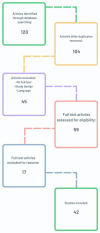Occupational Carpal Tunnel Syndrome: a scoping review of causes, mechanisms, diagnosis, and intervention strategies
- PMID: 38841666
- PMCID: PMC11150592
- DOI: 10.3389/fpubh.2024.1407302
Occupational Carpal Tunnel Syndrome: a scoping review of causes, mechanisms, diagnosis, and intervention strategies
Abstract
Carpal Tunnel Syndrome (CTS) has traditionally been viewed as a specialized medical condition. However, its escalating prevalence among professionals across a multitude of industries has sparked substantial interest in recent years. This review aims to delve into CTS as an occupational disease, focusing on its epidemiological patterns, risk factors, symptoms, and management options, particularly emphasizing its relevance in professional environments. The complex interaction of anatomical, biomechanical, and pathophysiological factors that contribute to the development of CTS in different work settings underlines the critical role of ergonomic measures, prompt clinical identification, and tailored treatment plans in reducing its effects. Nevertheless, the challenges presented by existing research, including diverse methodologies and definitions, highlight the need for more unified protocols to thoroughly understand and tackle this issue. There's a pressing demand for more in-depth research into the epidemiology of CTS, its injury mechanisms, and the potential role of targeted medicine. Moreover, recognizing CTS's wider ramifications beyond personal health is essential. The economic burden associated with CTS-related healthcare costs, productivity losses, and compensation claims can significantly impact both businesses and the broader society. Therefore, initiatives aimed at preventing CTS through workplace interventions, education, and early intervention programs not only benefit the affected individuals but also contribute to the overall well-being of the workforce and economic productivity. By fostering a collaborative approach among healthcare professionals, employers, policymakers, and other stakeholders, we can strive towards creating safer and healthier work environments while effectively managing the challenges posed by CTS in occupational settings.
Keywords: Carpal Tunnel Syndrome (CTS); Carpal Tunnel Syndrome treatment; epidemiology CTS; occupational CTS; work-related CTS.
Copyright © 2024 Rotaru-Zavaleanu, Lungulescu, Bunescu, Vasile, Gheorman, Gresita and Dinescu.
Conflict of interest statement
The authors declare that the research was conducted in the absence of any commercial or financial relationships that could be construed as a potential conflict of interest.
Figures
Similar articles
-
Prevalence and severity of carpal tunnel syndrome symptoms among Iranian butchers and their association with occupational risk factors: Implications for ergonomic interventions.Work. 2020;66(4):817-825. doi: 10.3233/WOR-203227. Work. 2020. PMID: 32925141
-
Carpal tunnel syndrome as an occupational disease.J Am Board Fam Pract. 2003 Nov-Dec;16(6):533-42. doi: 10.3122/jabfm.16.6.533. J Am Board Fam Pract. 2003. PMID: 14963080 Review.
-
Carpal tunnel syndrome among laboratory technicians in relation to personal and ergonomic factors at work.J Occup Health. 2017 Nov 25;59(6):513-520. doi: 10.1539/joh.16-0279-OA. Epub 2017 Aug 31. J Occup Health. 2017. PMID: 28855446 Free PMC article.
-
Clinical evaluation and management of work-related carpal tunnel syndrome.Am J Ind Med. 2000 Jan;37(1):62-74. doi: 10.1002/(sici)1097-0274(200001)37:1<62::aid-ajim6>3.0.co;2-d. Am J Ind Med. 2000. PMID: 10573597 Review.
-
Theoretical impact of simulated workplace-based primary prevention of carpal tunnel syndrome in a French region.BMC Public Health. 2018 Apr 2;18(1):426. doi: 10.1186/s12889-018-5328-6. BMC Public Health. 2018. PMID: 29606118 Free PMC article.
Cited by
-
Global and Regional Prevalence of Carpal Tunnel Syndrome: A Meta-Analysis Based on a Systematic Review.Musculoskeletal Care. 2024 Dec;22(4):e70024. doi: 10.1002/msc.70024. Musculoskeletal Care. 2024. PMID: 39672798 Free PMC article.
-
Hydrogel-Based Innovations in Carpal Tunnel Syndrome: Bridging Pathophysiological Complexities and Translational Therapeutic Gaps.Gels. 2025 Jan 9;11(1):52. doi: 10.3390/gels11010052. Gels. 2025. PMID: 39852023 Free PMC article. Review.
-
Retrospective Analysis of Carpal Tunnel Syndrome: Clinical Profile, Demographics, and Risk Factors at Sohar Hospital Over a Two-Year Period.Cureus. 2025 Jun 26;17(6):e86777. doi: 10.7759/cureus.86777. eCollection 2025 Jun. Cureus. 2025. PMID: 40718287 Free PMC article.
-
Mediators of the association between educational attainment and carpal tunnel syndrome: A 2-sample, 2-step Mendelian randomization study.Medicine (Baltimore). 2024 Oct 25;103(43):e40302. doi: 10.1097/MD.0000000000040302. Medicine (Baltimore). 2024. PMID: 39470489 Free PMC article.
-
Obesity as a Risk Factor for Carpal Tunnel Syndrome Independent of Diabetes Mellitus: A Nationwide Study.J Hand Surg Glob Online. 2025 Mar 8;7(3):100707. doi: 10.1016/j.jhsg.2025.01.016. eCollection 2025 May. J Hand Surg Glob Online. 2025. PMID: 40496419 Free PMC article.
References
-
- de Krom MC, de Krom CJ, Spaans F. Carpal tunnel syndrome: diagnosis, treatment, prevention and its relevance to dentistry. Ned Tijdschr Tandheelkd. (2009) 116:97–101. PMID: - PubMed
Publication types
MeSH terms
LinkOut - more resources
Full Text Sources
Medical
Research Materials


